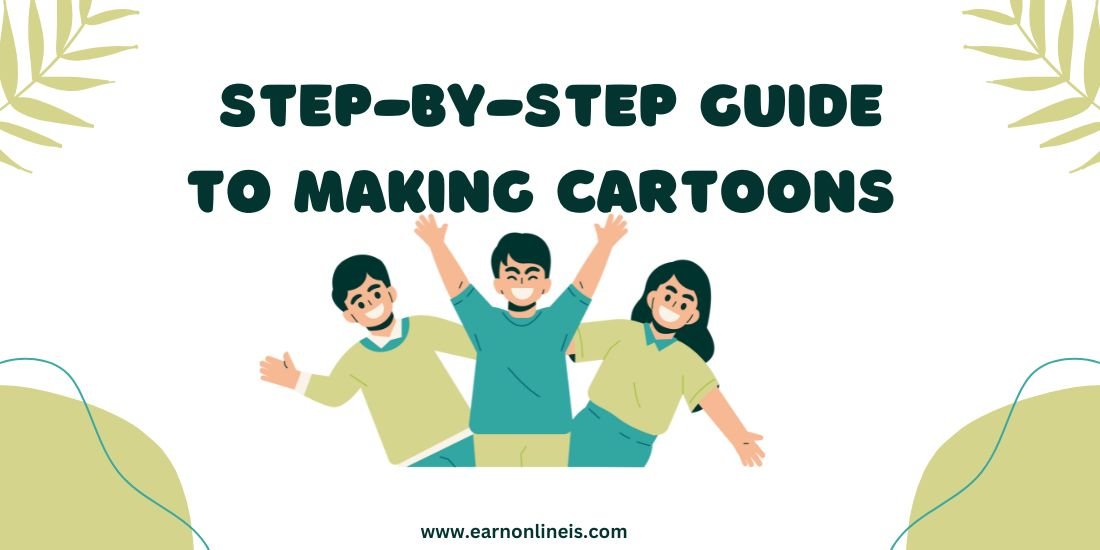Step-by-Step Guide to Making Cartoons
Introduction
Have you ever watched a cartoon and thought, “I want to create something like that!”? Cartoons in a human style combine storytelling with visually captivating characters that resemble real people but with a creative twist. They’re enjoyable, relatable, and often leave a lasting impact. Whether a beginner or an aspiring professional, this guide will take you through a step-by-step guide to making cartoons.
Getting Started with Cartooning
Before you jump in, it’s important to grasp what makes cartoons unique. Originality and creativity are crucial. The cartoon world thrives on fresh perspectives and ideas. Don’t fret if you don’t consider yourself a natural artist; cartooning is a skill that can be developed with practice.
Tools You Need for Cartooning
Traditional Tools for Hand-Drawn Cartoons
- – Pencils, erasers, and fine-tip pens
- – Sketchbooks or quality paper
- – Markers or watercolor paints for coloring
Digital Tools and Software
- – Drawing tablets (e.g., Wacom, Huion)
- – Software like Adobe Animate, Clip Studio Paint, or Procreate
Choosing the Right Platform
Free tools like Krita or MediBang Paint are fantastic options if you’re just starting. As you progress, you can invest in paid tools that offer more advanced features.
Developing a Concept
Every great cartoon begins with a concept. What’s your story? Who are your characters? Start by brainstorming ideas. Inspiration can come from anywhere—movies, books, or everyday experiences. Create a script or storyline to steer your cartoon.
Designing Characters
The characters you create are the essence of your cartoon.
Principles of Human-Styled Character Design
Utilize simplified anatomy to ensure characters are easy to draw consistently. Highlight key features such as large eyes or exaggerated facial expressions.
Adding Personality and Expressions
To make your characters unforgettable, give them unique personalities. Play around with facial expressions and body language to effectively express emotions.
Sketching Your Ideas
Begin with rough sketches to outline your characters and scenes. Don’t stress about achieving perfection at this stage; concentrate on capturing the core of your idea. Gradually refine these sketches into more polished drafts.
Learning Anatomy for Human-Like Cartoons
Although cartoons simplify human anatomy, having a grasp of the basics is essential. Practice drawing proportions, paying special attention to heads, hands, and poses. Incorporating exaggeration—like oversized heads or stretched limbs—can enhance the appeal of your characters.
Adding Details to Your Characters
Details breathe life into your characters. From expressive eyes to distinctive outfits, small elements can make a significant impact. Think about accessories or props that showcase your character’s personality.
Background and Scene Creation
A fantastic cartoon is not solely about the characters; the setting is equally important. Experiment with perspective to create depth, and design environments that enhance your characters and storyline.
Coloring and Shading Techniques
Coloring is where your cartoon truly comes alive. Select a color palette that mirrors the mood of your story. Incorporating shading and highlights can provide your characters with a 3D effect, making them stand out on the screen.
Animation Basics for Cartoons
Are you ready to bring your characters to life? Animation requires an understanding of motion and timing. Start with basic actions like walking or blinking. Employ techniques such as keyframing and tweening to achieve smooth transitions.
Adding Sound Effects and Voiceovers
In the realm of multimedia production, sound effects, and voiceovers are vital for enriching the audience’s experience. Whether in films, video games, advertisements, or instructional videos, these elements contribute depth, emotion, and clarity to the content. They not only complement the visual components but also foster an immersive atmosphere that captivates viewers. This article delves into the importance, techniques, and tips for effectively incorporating sound effects and voiceovers.
The Role of Sound Effects
Sound effects are auditory components that enhance the realism or emotional resonance of a scene. They encompass environmental sounds (such as rain, thunder, or footsteps), action sounds (like explosions, punches, or car screeches), and imaginative effects (sci-fi lasers or magical whooshes). These sounds help set the mood, highlight actions, and provide context. For instance, a tense moment in a film becomes more gripping with appropriate background sounds, such as a heartbeat or creaking floorboards.
The Role of Voiceovers
Voiceovers consist of spoken words integrated into a video or audio production. They can narrate stories, offer instructions, or infuse personality into a character. In advertisements, a captivating voiceover can convey a persuasive message to the audience. In video games or animated films, voiceovers animate characters, forging a connection between the audience and the narrative. A skillfully executed voiceover enhances professionalism, clarity, and relatability in the content.
Strategies for Incorporating Sound Effects
- Planning and Storyboarding: Prior to adding sound effects, it’s crucial to strategize their placement. A storyboard or script can assist in pinpointing key moments that need auditory emphasis.
- Layering Sounds: To achieve a realistic auditory experience, it’s important to layer various sound effects. For example, a car crash could include tire screeches, metal crunching, glass shattering, and distant screams. This layering technique adds depth and authenticity.
- Timing and Synchronization: Proper timing is essential when incorporating sound effects. Make sure that each sound aligns perfectly with the visual cues, such as a door creaking at the moment the door opens.
- Using High-Quality Effects: It’s worth investing in high-quality sound effects or recording your own with professional equipment. Low-quality sounds can undermine the overall credibility of the production.
- Sound Libraries and Tools: Numerous online libraries provide a wide array of sound effects. Software like Adobe Audition, Audacity, and Logic Pro X are excellent choices for editing and mixing audio.
Techniques for Adding Voiceovers
- Script Preparation: A well-prepared script is crucial for ensuring the voiceover effectively communicates the intended message. Adjust the tone, style, and vocabulary to fit the target audience.
- Choosing the Right Voice Talent: It’s important to select a voice artist whose tone, pitch, and delivery align with the project’s needs. For instance, a soft and warm voice may be ideal for a children’s audiobook, while a strong and assertive voice is better suited for a corporate advertisement.
- Professional Recording: Recording in a soundproof studio is key to eliminating background noise. Utilize high-quality microphones and audio interfaces to achieve clear and crisp recordings.
- Post-Processing: After recording, edit the voiceover to remove any breaths, adjust volume levels, and enhance clarity. Tools like EQ (equalization) and compression can help balance the audio effectively.
- Integration with Other Audio: Make sure the voiceover integrates smoothly with other sounds and music. It’s important to avoid overpowering or underwhelming the voice by carefully balancing the overall audio mix.
Tips for Successful Integration
- Understand the Audience: Customize sound effects and voiceovers to match the preferences and expectations of your audience. For instance, younger listeners may enjoy lively and vibrant sounds, while older audiences might lean towards more understated effects.
- Test and Iterate: Conduct tests with a focus group or colleagues to collect feedback. Make necessary adjustments to enhance the overall quality.
- Maintain Consistency: Keep a consistent tone and style throughout the production. Sudden changes can break the audience’s immersion.
- Legal Considerations: Always use royalty-free or licensed sound effects and voiceovers to steer clear of copyright issues.
Sound adds an extra layer of immersion to your cartoons. Record voiceovers or utilize royalty-free sound effects to enhance the experience.
Finalizing and Exporting Your Cartoon
After finishing your cartoon, take the time to review it carefully. Make any necessary edits, ensure the sound is perfectly synchronized, and select the appropriate format for sharing. MP4 and GIF are widely used options.
Conclusion:
Step-by-Step Guide to Making Cartoons in a human style is a fulfilling mix of artistry, imagination, and skill. By learning the basics, trying out different tools, and embracing your unique perspective, you can bring engaging stories to life. Whether your goal is to entertain, educate, or promote a brand, cartoons serve as a powerful way to connect with your audience. Keep in mind that consistency and creativity are your greatest allies on this journey. Start small, dream big, and enjoy the process of turning ideas into visual masterpieces. If you’re eager to turn your creations into a source of income, consider exploring platforms like Fiverr, Etsy, or Patreon to showcase and monetize your cartooning talents online.
FAQs:
- What skills do I need to create cartoons?
You’ll need some basic drawing skills, a dash of creativity, and familiarity with animation software.
- Can I make cartoons without drawing skills?
Yes! There are plenty of tools and tutorials available to help you grasp the basics or even create cartoons using pre-made assets.
- What software is best for beginners?
Procreate, Krita, and Adobe Animate are excellent starting points for newcomers.
- How long does it take to create a cartoon?
It varies based on complexity. A simple cartoon might take a few hours, while an animated short could take weeks.
- Can I sell my cartoons online?
Definitely! Platforms like YouTube, Patreon, and Etsy are fantastic for monetizing your cartoons.










